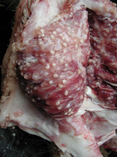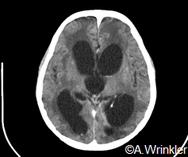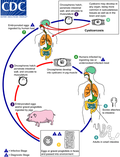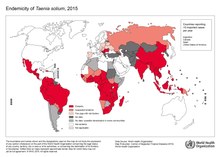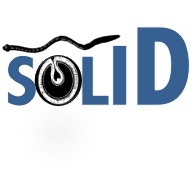Taenia solium in endemic areas
Introduction
Taenia solium taeniasis/cysticercosis is a zoonotic parasitic disease complex ranked first on the FAO/WHO list of foodborne parasitic infections (FAO/WHO, 2014) and fourth on the 31 investigated foodborne hazards described in a recent report on the WHO Global Estimates and Regional Comparisons of the Burden of Foodborne Disease in 2010 (Havelaar et al., 2015).
The normal life cycle entails a human final host with the adult tapeworm (taeniasis) and a pig intermediate host with the metacestode larval stage (cysticercosis). People get infected by the consumption of undercooked infected pork. Pigs get infected by the consumption of infected human stool with tapeworm eggs/proglottids. Unfortunately, people can also act as dead end intermediate host, after ingestion of tapeworm eggs via fecal-oral contamination, whereby the larval stages have a tendency to settle in the human central nervous system (Murrell, 2005). The latter condition, neurocysticercosis (NCC) is responsible of about 30% of acquired epilepsy cases in endemic areas (Ndimubanzi et al., 2010).
Taenia solium in endemic areas
The parasite occurs primarily in developing countries, where conditions of poverty, low sanitation and free-range pig keeping prevail, and meat inspection is mostly absent. Prevalence of active cysticercosis infection of 20% in humans and over 60% in pigs have been described (Coral-Almeida et al., 2015). CT scan studies in highly endemic areas estimated that over half of the acquired epilepsy cases in those areas were due to NCC, indicating the urgent need for control (Mwape et al., 2015).
Ongoing projects
- CYSTISTOP: "Elimination or control, what is the best way forward for Sub Saharan Africa?"
This project is a large-scale intervention study in Zambia which assesses whether elimination of Taenia solium is possible under Sub Saharan Africa (SSA) conditions and what the most cost efficient solution for SSA would be, control or elimination.
Funding:
Institute of Tropical Medicine, Antwerp (SOFI) and GALVMED
Partners:
Belgium: Institute of Tropical Medicine, Antwerp (P. Dorny, E. Bottieau, D. Berkvens, S. Thys, P. Lefèvre); Ghent University, Faculty of Veterinary Medicine (S. Gabriël, I. Van Damme); Université catholique de Louvain, Faculty of Public Health (N. Speybroeck); Scientific Institute of Public Health (B. Devleesschauwer).
Zambia: University of Zambia, School of Veterinary Medicine (K.E. Mwape, I.K. Phiri); Zambian Ministry of Health (G. Zulu)
St Kitts and Nevis: Ross University School of Veterinary Medicine (A.L. Willingham)
Students: E.C Hobbs (Ross University School of Veterinary Medicine-Ghent University-Institute of Tropical Medicine), C. Mwelwa (University of Zambia)
- SOLID: "Evaluation of an antibody detecting point-of-care test for the diagnosis of Taenia solium taeniasis and (neuro)cysticercosis in communities and primary care settings of highly endemic, resource-poor areas in sub Saharan Africa, including capacity building."
The main objective of this project is to contribute to the implementation of a rapid, cheap and simple point of care (POC) test for the detection of T. solium taeniasis and (neuro)cysticercosis in two resource-poor, highly endemic areas in sub-Saharan Africa. The project will field validate the CDC POC test, in Tanzania and Zambia, at the community and primary health facility levels. The project also aims to improve the T. solium disease recognition, diagnostic and clinical case management capacities of these countries as well as their capacity to conduct diagnostic and clinical studies.
Funding:
EDCTP (European and Developing Countries Clinical Trials Partnership), BMBF (German Federal Ministry of Education and Research)
Partners:
Belgium: Institute of Tropical Medicine, Antwerp (P. Dorny, E. Bottieau, V. Dermauw); Ghent University, Faculty of Veterinary Medicine (S. Gabriël, I. Van Damme), Faculty of Sciences (E. Abatih)
Germany: Department of Neurology, Technical University of Munich (V. Schmidt, A. Winkler)
Denmark: Faculty of Health and Medical Sciences, University of Copenhagen (M. Vang Johansen & P. Magnussen); Statens Serum Institut (R. Stensvold)
Tanzania: National Institute for Medical Research, Muhimbili Medical Research Centre (B. Ngowi); Ministry of Health (B. Ndawi); Sokoine University (H. Ngowi)
Zambia: School of Veterinary Medicine, University of Zambia (E.K. Mwape, I.K. Phiri); University Teaching Hospital (C. Chabala, O. Ciccone); Ministry of Health (G. Zulu)
Website:
- COST ACTION TD1302 CYSTINET
Taenia solium (pork tapeworm) and T. saginata (beef tapeworm) cysticercosis (CC)/taeniosis are zoonoses of public health importance, with significant economic impacts on the health and meat (pork and beef) sectors within and outside the EU. The main objective of this Action is to build a strong, extensive, multi-disciplinary scientific network to induce sustainable collaborations with the aim to advance knowledge and understanding of these zoonotic disease complexes. Specific objectives include the development of innovative diagnostic and cost-efficient control tools, assessments of disease burden and economic impact, as well as the development of harmonized reporting and management procedures. Intra-European collaboration is essential to stop the development of these diseases within the EU.
Funding:
COST
Partners:
- 36 countries/organisations, see http://www.cost.eu/COST_Actions/fa/TD1302?parties
- Also: www.cystinet.org
